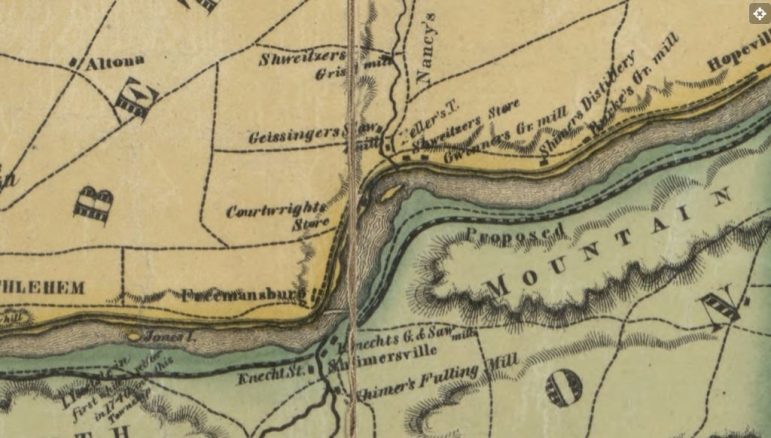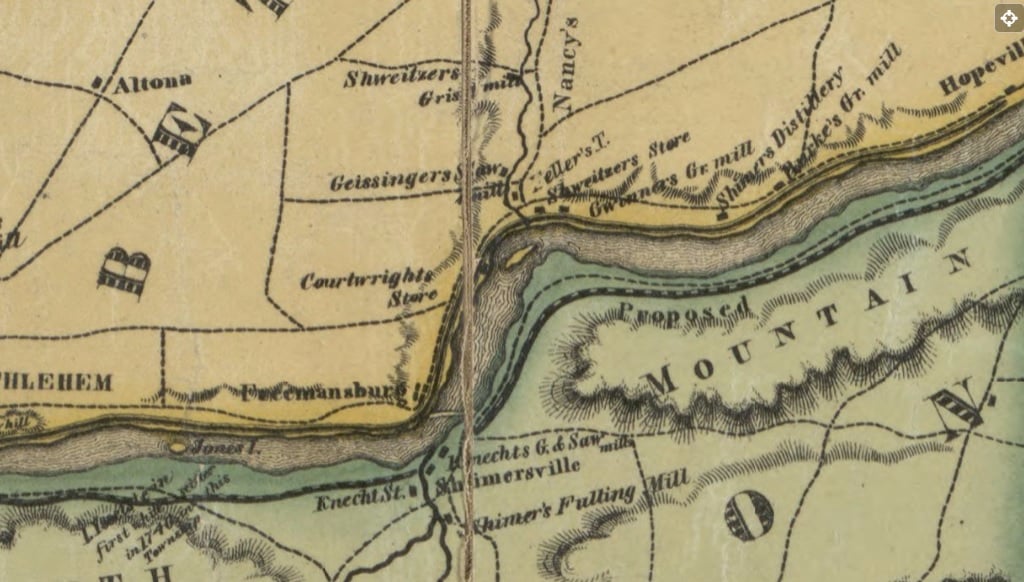
From the mid-1800s through World War I (1914-1918), the village of Redington was an important industrial center on the south bank of the Lehigh River in Lower Saucon Township.
By Jim Friedman
By the mid-1800s–when the now largely-forgotten community of Redington was founded along the Lehigh River in Lower Saucon Township–the industrial revolution was in full swing, with railroads and steel-making leading the way.
The process of steel-making required ‘pig iron,’ and Pennsylvania was known for its iron ore deposits. In fact, when Israel Acrelius, a Swedish missionary, published this observation in 1759, he wrote, “Pennsylvania, in regard to its iron-works, is the most advanced of all the American colonies.”
In the 19th century industrialists flocked to the Lehigh Valley and made large land purchases.
Among them was William T. Carter, a Philadelphian who made a fortune in coal. A good friend and an associate of Asa Packer, Carter bought 65 acres from Packer along the Lehigh River in an area named Lime Ridge. He named the area Redington, after his wife Cornelia Redington Carter.
In 1869, the first blast furnace of the Coleraine Iron Company was fired there, and soon after Carter built homes for the workers along with a mansion for himself, even though he mostly ran the business from his office or Rittenhouse Square home in Philadelphia.

Redington was once home to the splendid mansion of wealthy Philadelphia industrialist William T. Carter. It was destroyed by fire in 1933.
Carter’s brother-in-law, Walter Redington, took an interest in the foundry and lived at the Redington mansion with his wife. The small town became increasingly popular and began to grow on both sides of the Lehigh River. A railroad station, post office, hotel and general store made living there more convenient for residents.
Passenger trains would make eight to 10 stops daily at the height of the community’s prominence, and 48 ‘company’ homes were built, according to George Weiss, who lived on a farm nearby.
During World War I (1914-1918), the Bethlehem Steel Company built shells for the armies of Italy, France and England at Redington.
When the U.S. entered the war in 1917, Redington was abuzz. Workers from Bethlehem Steel even took trains back and forth because there wasn’t enough housing available.
Bethlehem Steel’s munitions plant in Redington included three office buildings, an electrical shop, a chemical laboratory, two shell storage buildings and several guardhouses. The munitions produced there were used during both the Spanish-American War (1898) and World War I. A proving ground on which munitions were tested was created and today is part of the Steel City Gun Club property.

At the peak period of production, close to 1,500 people worked at the Redington plant and some commuted there from as far away as Jim Thorpe. A nitroglycerine plant was also built and filled shells were shipped out daily. When the Steel built armor plate, one would be shipped to Redington proving ground and tested alongside new cannons. Stories were told of barn windows a mile away breaking from the blasts.
Redington was on the map thanks in part to the Steel and the proving ground was very well-known throughout America. In fact, some say it was as popular as today’s Aberdeen, Md., test site is.
William Carter had been a typical Victorian-era husband and protected his wife from involvement in his businesses. His will contained a trust arrangement which gave her the interest from his estate to provide for her personal needs until her death.
Mrs. Carter had busied herself with travel, charity, modest philanthropy and a wide social circle of friends.
William Carter frequently visited his mines in Hazleton and had done so on Feb. 4, 1893. He returned to his Philadelphia home at 2116 Walnut Street that evening and became ill. Days later, he was diagnosed with pneumonia, to which he succumbed on Feb. 9, 1893. It was reported at the time of his death that his worth was $3.4 million. He is buried in a large family mausoleum in the historic West Laurel Hill Cemetery in Bala Cynwyd, Pa.
Mrs. Carter knew the iron-making competition was overwhelming and also of the possibility that Coleraine wouldn’t last, so she devised other plans.
She closed the furnaces during the Panic of 1893 and in 1899 leased land to the Steel. She also turned some of the property into quarries run by her family.
Cornelia Carter then started the George Junior Republic, later renamed Carter Junior Republic after her late husband. A year-round youth education and rehabilitation facility, it was one of her personal charities. The Republic motto was “Nothing Without Labor.” Troubled youth, mostly from Philadelphia, were housed there for rehabilitation.
The facility stressed that only by gainful employment within their Republic community could the “citizens” accumulate the capital to acquire creature comforts. For employment the Republic offered carpentry, printing, bakery and furniture shops, several small stores, restaurants, a farm, an orchard, a laundry, a bank and a hotel. Citizens organized political parties, conducted campaigns and elected a president, justices, police and both legislative and administrative officers. They wrote their own laws, set their own civil and criminal penalties, locked up the guilty in a Republic jail and taught themselves (under guidance from adult leaders) the benefits of an elected democracy in a capitalistic society.
The ‘jail’ was the gymnasium for a reason. When a prisoner was locked up, no one could use the facility. This was the lesson to show how one bad person could affect the rest.
There were many escapes and sometimes police and parents would threaten children that if they were bad, they’d be sent to Carter. A Morning Call article highlighted the death of a boy who had adjusted the coal stove in the jail and accidentally asphyxiated himself.
The Carter Junior Republic operated from 1899 until financial strain closed it in 1924. Mrs. Carter started a foundation at the University of Pennsylvania to continue helping youth.
Walter J. Redington still lived in the mansion. Shortly after 8 p.m. on May 2, 1933, Austin Heater was delivering wood there. He and a 20-year-old caretaker, Arthur Folson, heard a call for help from the 75-year-old Redington. They rushed to his aid but were unable to get to him due to the heavy smoke and flames consuming the building. His charred remains were found at 7 a.m. the next day by firefighters. Later that year, on Sept. 1, 1933, the Redington post office was officially closed.
By then the dwindling town of Redington was disappearing. At one point there was promise and potential for the tiny community to become larger, but it was not to be. Today, a one-way road winds through this small section of the township colloquially known as “The Narrows,” snaking past a busy railway, woods and a handful of homes.
The Carters had three children: William Jr., Alice and Helen, all of whom lived at the family home in Philadelphia. William Jr. amassed a large fortune when his father died and was a member of the University of Pennsylvania’s Class of 1896, but dropped out to pursue hunting and polo. He married a socialite and had two children. They vacationed in England often, and on one such trip in March 1912 decided to return to America and made reservations on the Olympic. At the last minute, they changed their minds and booked cabins on the doomed maiden voyage of the Titanic.
Published reports tell two different stories of William Carter’s family’s rescue. Carter’s wife’s sworn statement revealed that William had not accompanied her and their children to Lifeboat 4 to ensure their safety. “We sailed for America on the Titanic,” she said. “When the Titanic struck, my husband came to our stateroom and said: ‘Get up and dress yourself and the children.’ I never saw him again until I arrived at the Carpathia at 8 o’clock the next morning, when I saw him leaning on the rail. All he said was that he had had a jolly good breakfast and that he never thought I would make it.” The controversy over Carter’s apparent callousness was made worse by sensational newspaper accounts of their subsequent divorce on the grounds of “cruel and barbarous treatment.”
William died at 65 while on vacation in Palm Beach, Fla., in 1940. He is buried with his parents.
Before Redington was industrialized, the area it occupied was mainly farmland. The first settlers of the area were the Shimers, also spelled Sheimer or Shymer, and the Carter home may have been the original Shimer homestead.
The family had many children and mills and tanneries along the Lehigh. The hamlet of Shimersville was created just south of Freemansburg. One of the boys, Boyer Luther Shimer, purchased a farm in Hanover Township, Lehigh County, that covered the current area from Seventh Avenue to Pennsylvania Avenue. Later, the area became the Borough of West Bethlehem, which eventually became part of the City of Bethlehem.
Shimer later sold off parcels of land to prominent Bethlehem Steel executives, including his own home, which was purchased by company president Eugene Grace. On that site, Grace eventually built his mansion, which is now home to Holy Family Senior Living.
Shimer also was instrumental in widening West Broad Street from Main Street to Pennsylvania Avenue, as a second trolley rail was planned for the narrow roadway and would have caused significant traffic. B. Luther Shimer later built his beautiful home at 359 Tenth Avenue in West Bethlehem and lived his remaining days there.

The mansion built by B. Luther Shimer is still a private residence in one of West Bethlehem’s most desirable neighborhoods.
About the Author: Jim Friedman is an admin for the local history Facebook group, Bethlehem, PA: For History Lovers. This post is republished here with his permission.
Photos courtesy of Karen Samuels, Ancestry.com, Facebook, Google Maps and Pennsylvania Folklife Vol. 37, No. 2. Information from SauconSource.com, Newspapers.com, South Bethlehem Historical Society, Ancestry.com, History of Northampton County, Wikipedia.







